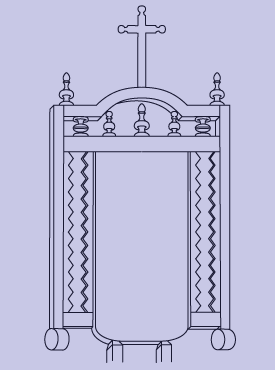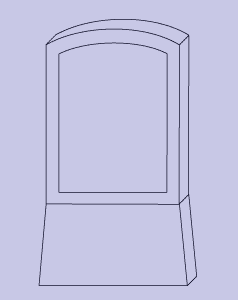 |
 |

|
Cmentarze Style Guide |
|
|
Many of the cemeteries are older than 200 years. Their appearance probably has changed a lot during this time period and often those changes followed the fashions of the time. What we find today are the remains of the cemeteries as they had been in 1945. This means that most of the remaining monuments have been created between 1880 and 1945. The different materials which were used for the monuments - cement, sandstone, granite, iron or wood - resisted time and the eventful history with different success. While viewing the broken monuments today, it is often difficult to imagine what they might have looked like when they were built. |
|

What did the monument look like? |
|
|
The observations made at many of the old colonist cemeteries in Central Poland and some additional research in literature provided the input for this little style guide of the cemeteries and monuments. It should give an impression of the original appearance of the cemeteries and it might be helpful for the interpretation of the pictures or for the research on site. |
|
The Layout of the CemeteriesCemeteries in urban and in rural environment looked very different. The urban cemeteries were much more influenced by different trends and fashions than the rural cemeteries. The cemeteries at Płock, Gostynin and Gąbin often show impressive stone sculptures or the remains of the once so popular neo-Gothic cast-iron structures. At the rural cemeteries these big monuments would have looked ridiculous, even if some of the well-off farmers could have afforded them. Since the urban cemeteries are much better conserved and documented this style guide concentrates on the rural cemeteries. The rural cemeteries usually had a rectangular form. There was always some kind of enclosure, like a wall or a fence. There was a broad main entrance and sometimes there were additional smaller doors at other sides of the cemetery. The main entrance usually consisted of a big gate - often formed as an archway - and smaller entrance doors at each side of the gate. |
|
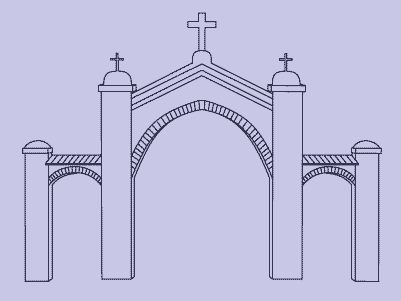
Cemetery gate at Ładne |
|
|
Today the main entrance of a cemetery can sometimes be found at a very unexpected place, since the layout of the roads has changed so much (the disappearance of the wooden houses made also many of the once heavily used roads disappear). In the center of a cemetery there was a 4-5 meters high wooden cross. If the cemetery was divided in different areas, there would have been a distinction between areas for children's graves, single graves and family graves. Family graves were bigger than single graves and certainly showed more expensive monuments. |
|
Form follows Fashion - the Shape of the MonumentsTill the end of the 19th century carved wooden crosses and painted wooden plates were usually used as grave markers. Since the beginning of the 20th century the wooden monuments were increasingly replaced by stone monuments. Most of the older wooden grave markers did not remain. The standard form for grave markers at the end of the 19th century were crosses. Accordingly most of the fragments we can find today at the old cemeteries are not gravestones but parts of crosses - very often parts of the pedestal. |
|
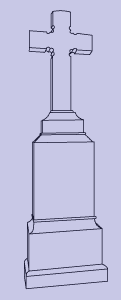
Cement Cross |
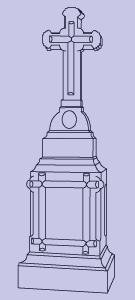
Cement Cross with rod ornaments |
|
Stone Crosses - These crosses often were made of cast concrete. The pedestals sometimes were made from brick stone. The inscription of the names and dates usually were on the front side of the pedestal. The backside of the pedestal often showed a verse from the bible. |
|
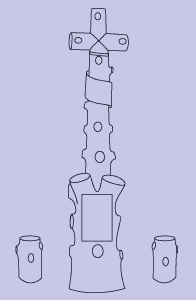
Granite cross shaped as a tree with low |
Bigger grave sites often showed some kind of enclosure formed by low columns connected by iron chains. The columns were usually made of the same material as the cross and followed the same style. Sandstone was seldom used for the crosses. Granite crosses - The monuments made from granite are the best conserved monuments at the old cemeteries. They also had the form of crosses. It was very popular at the beginning of the 20th century to give these crosses the shape of trees with cut off branches. The dead tree symbolized the transitoriness of life. |
|
Iron Crosses - Metal crosses were usually cast-iron crosses. Wrought-iron crosses are seldom found. Sometimes the grave sites were enclosed by iron fences which matched the style of the crosses. |
|
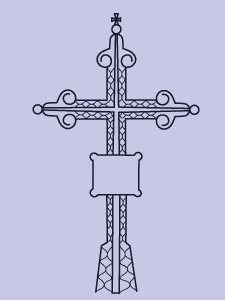
Wrought-iron Cross |
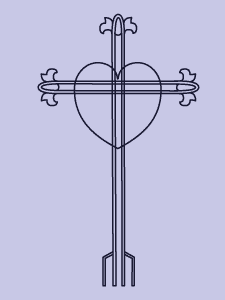
Cast-iron Cross |
|
Noticeable are iron crosses showing inscription plates in the form of a heart. Only at first sight these crosses give a somewhat sickly sweet impression - our today's taste is influenced by the highly commercial usage of the heart symbol (St Valentine's day, Mother's day). However a closer investigation reveals that these crosses symbolize the ancient Christian cardinal virtues: faith, hope and charity/love. The cross stands for faith, the heart stands for charity or love and the anchor shaped ends of the cross stand for hope. |
|
|
Wooden grave markers - must have been used frequently till the end of the 19th century. Wood was the ideal material in a rural environment and in a time when many of the daily used tools were made of wood. Besides wooden crosses the usage of wooden plates had been common. These plates were often standing on poles and sometimes formed part of a wooden fencing around the grave. The plates were often richly decorated with wood turned and carved elements. The sketches for the three wooden gravemarkers shown here, were found by Albert Breyer. One of the sketches showed notes of the colouring (yellow, green). So it can be assumed that these wooden gravemarkers were painted in vivid colours. |
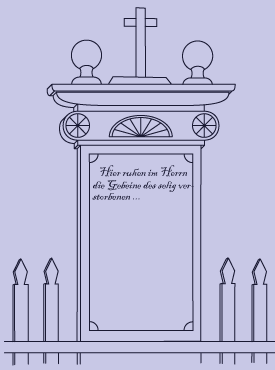
Wooden gravemarker at the cemetery of Łazińsk ca. 1932 - reproduction after a sketch by Albert Breyer |
|
Wooden gravemarker at the cemetery of Łazińsk ca. 1932 - reproduction after a sketch by Albert Breyer |
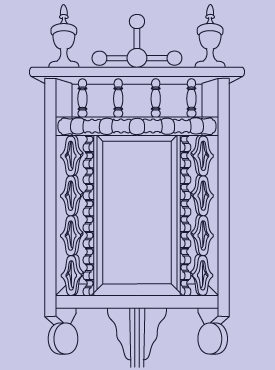
Wooden gravemarker at the cemetery of Łazińsk ca. 1932 - reproduction after a sketch by Albert Breyer |
|
Stone Slabs - quite frequently graves are covered by simple slabs made of stone or cement. Some of the slabs are absolutely plain and don't even show an inscription. These graves probably had additional wooden plates or crosses which did not remain. Other slabs show bas-relief fields for the inscription and a cross above the inscription. Simple ornaments like single flowers at the edges of the slab are usually the only additional decorations. |
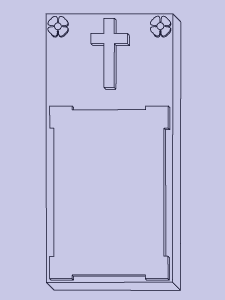
Stone Slab |
|
Grave Borders - Grave Borders were usually made of cement and showed chamfered shapes that remind of picture frames. Some of the grave borders show a low sloping pedestal at the head where the inscription plate has been attached. |
|
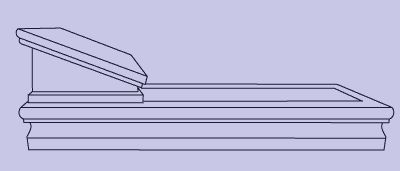
Grave Border with sloping pedestal |
|
|
If the sloping pedestal does not show an inscription, it probably had been carrying a wooden inscription plate which did not remain. Many graves show only a grave border, but no pedestal and no inscription plate. These graves might have been marked by wooden grave boards. These boards were fastened to poles at the head of the grave and often showed rich carvings and painted or carved inscriptions. Sarcophagus - Sometimes the grave borders were extremely high and covered by a slab. This form reminds very much of a sarcophagus and was often used for small graves (children's graves). Since the human remains had been buried in the earth under the monument, these monuments are not really sarcophaguses (stone coffins). Maybe this form of a monument had been used so frequently for children's graves, because it reminds of the protecting function of a cradle. Gravestones - Gravestones, which are very common today, had not been used very often at the change from the 19th to the 20th century. The cross form had dominated the cemeteries. The remaining gravestones usually show a rather simple form and unobtrusive inscriptions. Very seldom gravestones in the so called Frisian form can be found. The Frisian form shows a head like upper part and is derived from the very old form of a "Totenbrett" (old form of bier) which reflects the shape of a human being. |
|
|
Gravestone |
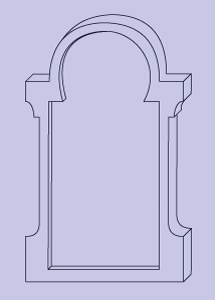
Gravestone in Frisian form |
|
Stele - Only in very rare cases a stele was used as grave monument (Sady). Like the Totenbrett a stele reminds of the shape of a human being - in case of the stele it even reminds of an upright standing person. Maybe this symbol was not used so often by the colonists at the end of the 19th century because it lacked an open confession to the Christian faith (no cross) and it did not match the idea of a humble Christian (upright standing human being). |
|
Decoration of the MonumentsThe most popular decorations used were floral ornaments, often simple flowers. Not so often used were tendrils or palm fronds. A cross was never missing. |
|
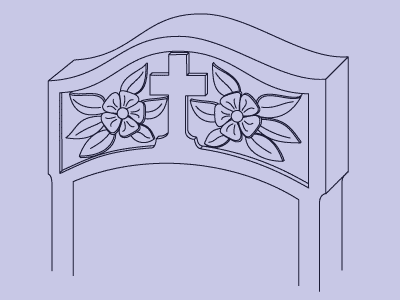
Gravestone in Czarne Błoto showing floral ornaments |
|
|
At the beginning of the 20th century it was very trendy to paint the cement of the monuments in shiny silver using an aluminum powder suspension. This paint has completely vanished today. But some of the monuments show an extremely smooth finish and it can be imagined that they had been decorated this way. Some of the grave borders show shiny black stones at the edges. These inlaid stones are imitated Jet stones. |
|
|
Jet is a very dense fossilized lignite (coal) that can easily be shaped and polished. At the end of the 19th century jet was a very popular material for mourning jewelry. Jet was too expensive for the decoration of grave monuments. The materials used to imitate it were ebonite, black acrylic resin or glass. |
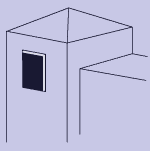
Imitated Jet decoration at a cement grave border |
InscriptionsAs far as the personal information was concerned, the inscriptions were usually rather short. Corresponding to the fashion of the 19th and 20th century only names and dates were given. A verse from the bible indicated the devoutness of the deceased and his family. At the end of the 19th and beginning of the 20th century Gothic script was the most popular type used for the inscriptions. After World War I the broken letter fonts became less popular for the inscriptions and simple serif fonts or sans serif fonts were used. Only very few inscriptions used an italic font. Really touching are inscriptions that were freehanded scratched into the wet cement. Inscriptions containing unusual wording or wrong spelling are not seldom and might not always be blamed on the stonemason. |
|
|
Literature: Fastenau, Jan - Märkische Grabmalkunst aus sieben Jahrhunderten, Berlin 1926 Der Friedhof unserer Mark. Anregendes zur Ausgestaltung unserer ländlichen Friedhöfe, Herausgegeben von der Brandenburgischen Provinzial-Bauberatungsstelle, Stransberg 1916 Schindler, Zeno H. - Spuren deutscher Volkskunst schlesischer Herkunft in Mittelpolen, in: Deutsche Wissenschaftliche Zeitschrift in Polen, Heft 29, 1935 Berz-Schilling, Chr. Otto - Volkstümliche Grabmalkunst und Friedhofgestaltung, Stuttgart 1911 |
|
|
Content and graphics: Jutta Dennerlein, 2006 |
|
